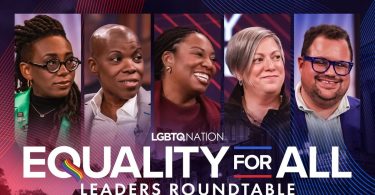As we at Outsports have put together our list of publicly out LGBTQ athletes in Paris for the Summer Olympic Games, one trend has clearly emerged: the number of out women far exceeds the number of out men.
To be sure, the number of out men at the Olympics has improved. There were three in 2012 in London (diving and equestrian), 11 in 2016 in Rio across several sports, 16 in Tokyo, and now at least 21 in Paris.
Yet while the number of out women we know of more than tripled in just the five years from Rio to Tokyo, the number of men hadn’t even doubled. Not even close.
While some on social media have launched into commentary about the need for men’s sports to change — and we certainly hope the environment for LGBTQ athletes continues to improve — there are other factors at play that have led to this dynamic.
Get off the sidelines and into the game
Related
Outsports and our readers have found so many of these out Olympic athletes simply by looking through Instagram posts.
Our criteria for being “publicly out” is not an easy threshold. We want to make sure the athlete has very clearly talked to the media about being LGBTQ, or they are very clearly living their life openly on social media.
That second part — living openly on social media — is something many women enjoy, yet the men seem to feel the need for a “coming out” moment. It reflects the fluidity of women’s sexual orientations we’ve heard about for a long time, and an increased comfort level in society with that.
Katie Barnes, a feature writer for ESPN, recalls the response to USA basketball player Elena Delle Donne coming out publicly in the media around the 2016 Rio Summer Olympics, and how that very casual moment in a Vogue article opened the door for other women to be publicly out in a casual way. Barnes said that before that moment, many women were “privately out,” meaning that various women were out to teammates and coaches but not the public.
With Delle Donne’s casual coming out, it opened the door for others to do so in a relaxed manner on social media.
“After that for a lot of women it wasn’t a secret, it just wasn’t discussed in the media,” Barnes said. “And now they’re just living that ‘privately out’ life openly on social media.”
To be sure, some men we’ve found to be out simply because they are sharing posts about their partners. American dressage rider Nick Wagman and Dutch sprinter Ramsey Angela come to mind.
Yet if more men lived their social-media lives like the women, we’d have a lot more men on our list of out Olympians.
I have asked many out women in elite-level American soccer, hockey and basketball this question: What percentage of your current team do you believe is LGBTQ?
The answers I’ve gotten have ranged from 30% to 80%.
It’s hard to believe any man in elite-level sports — Olympics, professional, or even high-level college — would say 80% of their team is LGBTQ.
At the same time, it’s also telling that the lowest number I’ve gotten from women is 30%.
“Women’s sports has had to deal with its own homophobic and transphobic systems,” Barnes said, “but overall women’s sports have been a haven for queer people. So it would make sense to me that there’s an over-representation of queer women competing in the women’s category.”
Barnes points to a difference of cultures that clearly exists between men’s and women’s sports as one of the reasons more LGBTQ people have simply gravitated toward women’s sports in a way they have not gravitated to many men’s sports.
“There are, and have been, many queer women who have competed in women’s sports on a level we haven’t seen in men’s sports because there’s so much less of an allowance of an expression of yourself in men’s sports,” Barnes said.
Reflective of that is, for example, how athletes in elite American women’s sports have been speaking up politically more loudly and for longer than a lot of athletes on the men’s side.
Take, for example, Team USA: Five of the female athletes in basketball we consider to be publicly out. For the men: Zero. For Brazil’s soccer teams: six out women, zero out men.
Same sport, same country, clearly very different people gravitating toward each sport.
Related
Because of these two dynamics, there is an increasing gap of fear of coming out between men’s sports and women’s sports, particularly depending on the sport.
When you see other people like you living life openly, it’s like a domino effect. Our motto at Outsports: Courage is contagious.
Add to that the fear-mongering so many continue to engage in the sports and news media about “loss of sponsorship” and “homophobia in sports,” and you have a recipe for 1) women seeing the truth through others’ journeys and being willing to break out, and 2) men having a harder time seeing it all simply because there are fewer out elite male athletes.
This dynamic of decreased fear of being-out for women in pro sports is recent.
“It wasn’t that long ago that it was a big deal that Brittney Griner and Layshia Clarendon were out as first round draftees,” Barnes reminded of the 2013 WNBA Draft.
Yet in that short period of time, consider this: There were almost as many publicly out women at the 2012 Summer Olympics as are publicly out men in 2021, nine years later.
That’s a lot of coming-outs and history to point to, women including Griner and Clarendon succeeding through their coming-out and being-out.
The total number of sports at the Paris Olympics that have publicly out male athletes as identified by Outsports is 12. That’s way up from just eight different sports in Tokyo that had out male athletes.
The number of women’s sports represented: at least 26.
That speaks to the culture of different sports.
“What’s happened in women’s sports is that these athletes are demonstrating various ways to be queer and live your life openly as that.” – Katie Barnes
Five of the out men we know of — almost a third of the whole group — are in equestrian. Less than 1% of the publicly out women are in that sport.
Diving? We know of two men and no women.
In fact, if you combined diving, equestrian and swimming, those three sports account for about 60% of the publicly out LGBTQ male athletes in Paris that we know of. Those three sports account for just 7% of all the sports being held at the Olympics.
Soccer, on the other hand, has over 40 out women and zero out men.
“I think in many ways what’s happened in women’s sports is that these athletes are demonstrating various ways to be queer and live your life openly as that,” Barnes said. “And it’s transformed how we view being ‘out,’ and it’s provided various ways for athletes to choose how they want to share their stories of their lives with their fans.”
We’ll keep pushing the sports world to more proactively support LGBTQ men and women across sports, Olympics or otherwise, who live their lives openly to inspire all of us.







